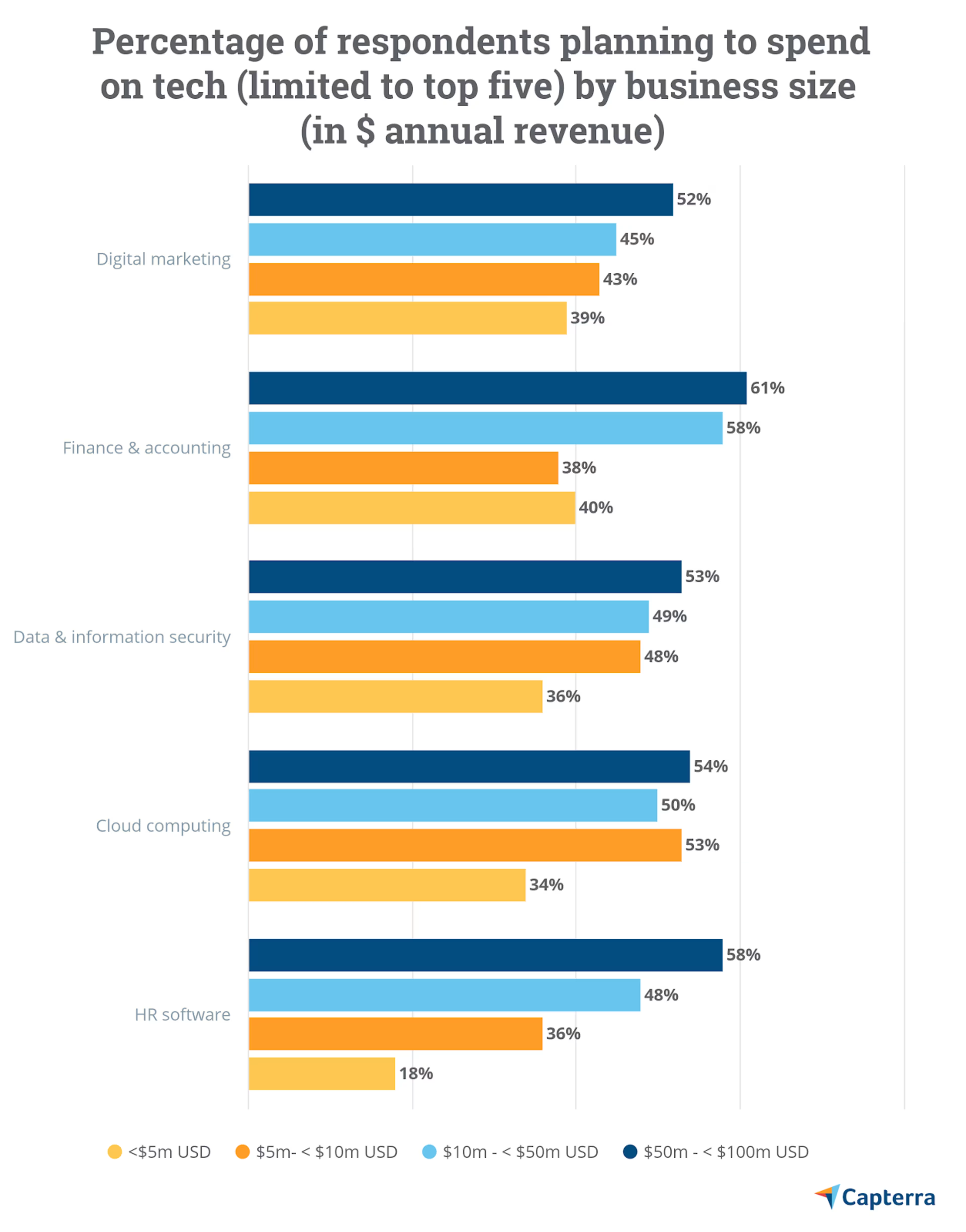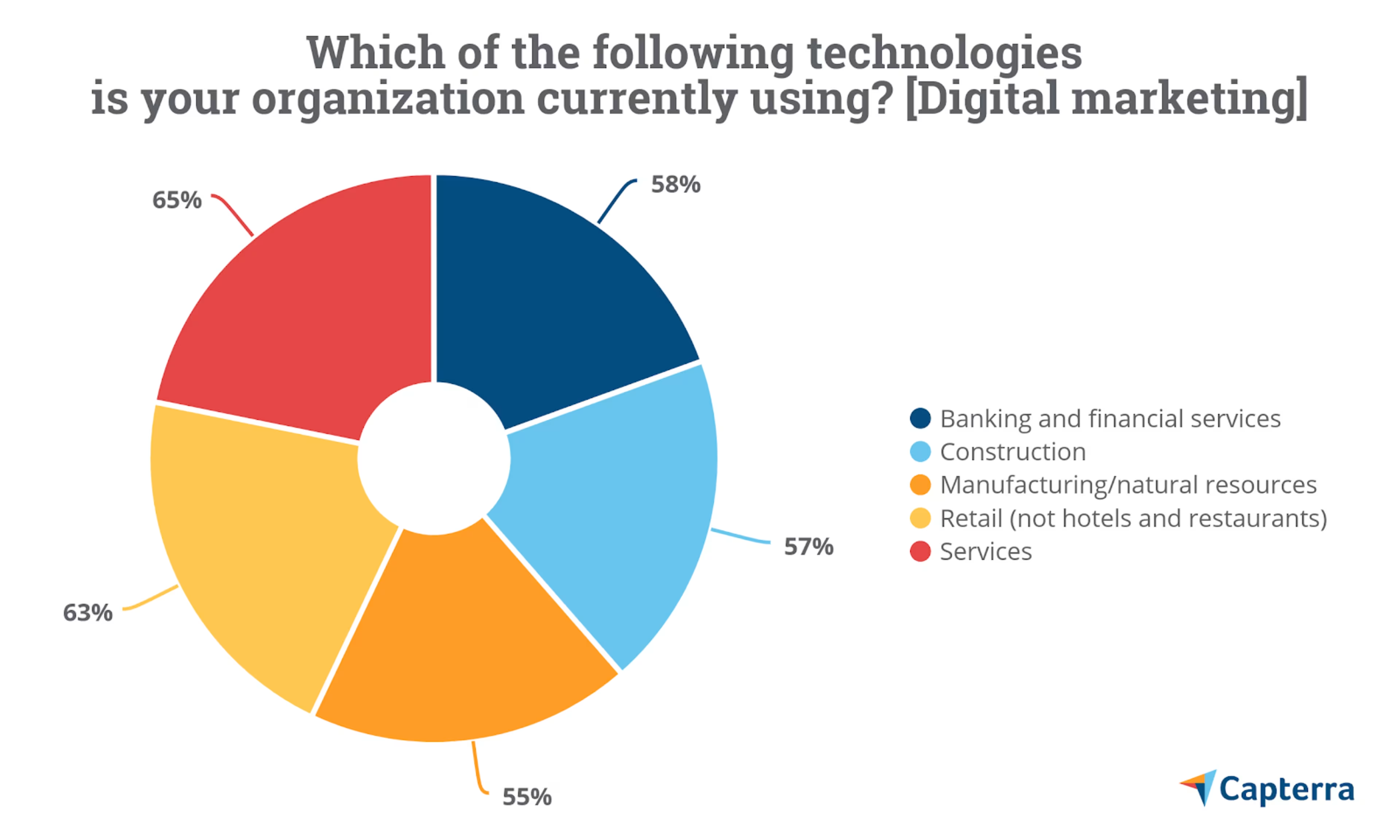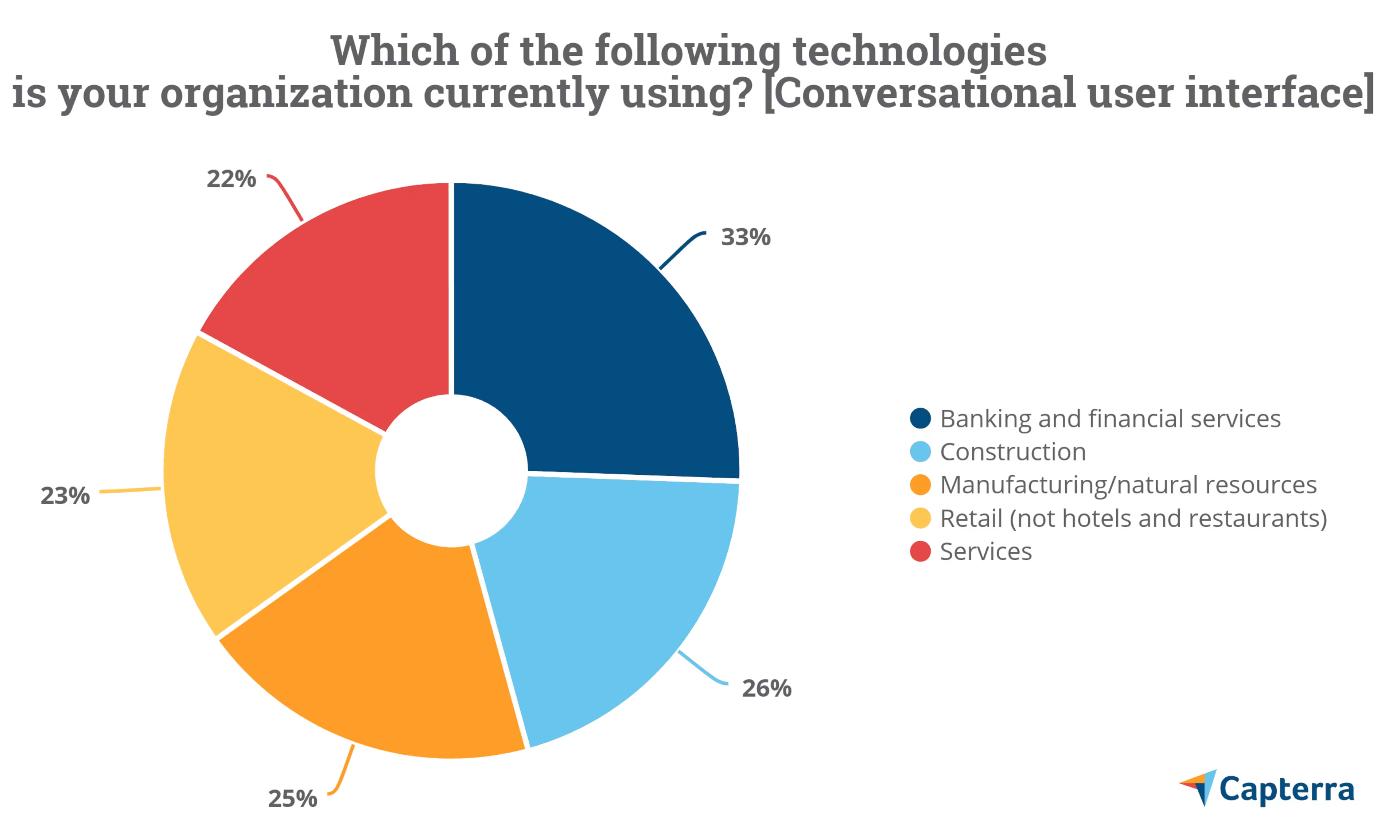Small businesses have a window of two to three years when they can adopt new tech and catch up to competitors. If two-thirds of your peers already use digital marketing—and say it's critical for their growth—2019 is your year to try surpassing them.

Capterra surveyed more than 700 SMBs in the United States and asked about their 2019 and 2020 business software purchasing intentions and budgets (learn more about our methodology here).
Regardless of industry and company size, 45% of respondents cited digital marketing as a key budgeting priority:

This is especially true for SMBs in industries like retail, where 63% of surveyed SMB owners use digital marketing and 68% say it's critical for them to do business.

Percentages reflect the number of respondents in each industry currently using digital marketing
Where to start with your digital marketing investment
Are you asking yourself which digital marketing tactics you should invest in? Look no further.
In this article, we'll take a look at four small-business marketing strategies your business should consider in 2019.
Each strategy is quickly gaining traction, but none is widespread enough to classify as mainstream. Adopting them early leaves an opening for you to sail ahead of your competition.
Sentiment analysis
What it is:
According to Forbes, sentiment analysis is "an automated process of understanding the emotional tone of a written opinion."
Sentiment analysis measures the quality of interactions between consumers and your brand, and you'll need to use it if you want to boost your brand's reputation.
Why it matters:
Gartner predicts that by 2025, 75 of the top 100 global consumer brands will lose 20% of their brand equity value as a result of declining brand perception and loyalty (full report available to Gartner clients).
Sentiment analysis can decrease your risk by predicting audience reactions to prospective campaigns. It's a tactic to help marketers build campaigns, then tailor the same marketing message to unique audiences. Gartner research cites examples such as:
Nuance detection. Finds patterns of tone and intent within documents, then writes summaries for users.
Customer intention records and analysis. Tracks the design decisions users make, then lets them see how different decisions would have impacted their outcomes without impacting the final product.
Anticipating outcomes. Predicts how the public will react to certain campaigns based on factors unique to each audience (e.g., location, market size). This technology lets marketing teams foresee where content will succeed or fail and use those insights to make and deliver more targeted campaigns.
How to try it:
Shop for software tools that specialize in sentiment analysis. Measuring tone and nuance in language is a tricky task, and many all-purpose marketing tools don't offer this functionality yet.
By narrowing your search to reputation management software with sentiment analysis, you can find tools such as Brandwatch (to monitor the tone of social media posts in real time) and RapidMiner (which lets you build predictive models for unstructured content sources, such as online reviews).
Chatbots
What it is:
Chatbots are computer programs that mimic conversations with real humans. They can either be text-based (for example, collaboration software) or voice-based (for example, a virtual assistant).
In the B2B world, chatbots are often tied to customer service. But they can provide significant value to marketers as well, including:
Data collection. In order for an AI product to succeed, businesses must train AI technologies using large datasets. Chatbots collect large amounts of data based on their interactions with customers. Segmented correctly, this can help marketers gain more insight into what consumers want.
Predictive analytics. Marketers can use data collected from chatbots to find patterns in consumer behavior, then respond in real time to actions that specific users perform.
Personalization. Many chatbot platforms integrate with social media to gather data on those they interact with. Armed with these details, chatbots can correctly answer customer queries and offer personal advice based on each shopper's history and preferences. More advanced bots (like ShopBot and Waylo) even shop for bargains on consumers' behalf, responding when consumers get the best prices for the products they want.
Why it matters:
Gartner research shows that one in five online customers in the United States, United Kingdom, and Germany already use chatbots. Among these users, more than one-third engage with a virtual personal assistant (VPA) at least once per day.
The explosion in IoT devices like Amazon's Alexa has made digital interactions more conversational. It's predicted that by 2020, customers will manage 85% of their relationships with companies without any human interaction.
Here's the challenge: SMBs aren't adopting chatbots fast enough to keep pace with consumer demand.

Percentages reflect the number of respondents in each industry currently using CUIs (chatbots)
Sixty-five percent of Millennials want to use chatbots. Yet, Gartner research found that among SMB leaders in five key industries, only 22 to 33% use chatbots. If you choose to invest in chatbots now, you can get ahead of your competition in a key way.
How to try it:
Consider asking your technical lead to build a bot if you have the in-house talent to do so. This can save time and money in the long run, rather than relying on an agency or external consultant.
The cost to build a chatbot will depend on your business requirements. In heavily regulated industries like finance, you'll need to build protocols into your bot, which will drive up the overall cost. If you work in an industry with a lot of consumer engagement (like retail), you'll need to account for a more diverse range of dialogues—which will also increase costs.
Building a chatbot for small-business marketing on Facebook Messenger can cost $3,000 to $5,000, but it can also cost no more than the amount of time needed to build. To minimize costs and maximize value, have a clear goal for your chatbot along with a clear understanding of requirements.
Voice search
What it is:
Voice search lets users search the web or devices by speaking their queries rather than typing them out. It's equivalent to saying, “OK, Google" into the Google app on your Android phone, then explaining your query rather than typing it into the search bar.
Voice search queries can reveal more details about user intent than typed queries. That's because unlike typing, voice searches reveal more nuance (such as changes in tone and inflections, aka sentiment). Over time, this allows voice search systems to keep collecting data from user interactions and improve their understanding of user sentiment.
And with voice search expected to grow over the next few years, the increasing volume of searches will help systems deliver more accurate results for consumers. Though we don't know the numbers as they stand now (Google doesn't share how many search queries are voice-based), ComScore predicts that half of all searches will be voice-based by 2020.
Why it matters:
The surge in voice search users is already here. A recent survey by BrandContent found that more than two in three of the 2,000 respondents had access to either a search or voice-activated assistant. Two in five said they use it to find restaurants, while one in three respondents over age 65 used it to plan their traffic routes.
Gartner predicts that by 2021, brands that redesign their websites to support visual and voice search will boost digital commerce revenue by 30% (full report available to Gartner clients). If you start utilizing voice search sooner rather than later, you can reach a huge market that most of your marketing peers haven't touched yet.
How to try it:
Delegate colleagues on your marketing team to confirm which keywords and search queries lead people to your web content. Then, test and optimize how your content surfaces when it's framed as a natural language question.
Don't forget to test and optimize your content across desktop, voice, and mobile search. Since most voice search queries are on mobile, it's essential to conduct a full SEO audit of your mobile site.
Unlike web searches, voice searches are query-driven. Rather than an endless list of indexed web pages, the goal is for voice search platforms to share one extremely relevant answer to your question.
To make sure your own site is found, confirm that your website's structure reflects your customer journey (the specific steps they take to find your site and make a purchase). If your common query strings match the faceted navigation on your eCommerce site, voice search users are more likely to find you.
Dynamic pricing
What it is:
Dynamic pricing lets businesses set flexible prices for products and services based on real-time market demands. If you've ever tried to call an Uber on New Year's Eve and seen prices increase fivefold, you've experienced dynamic pricing.
Frustrating as this tactic is at times, it helps businesses maximize their profits with each customer. Airlines, retailers, energy, and financial services firms have used dynamic pricing for decades.
In industries where consumer demand for products fluctuates (think taking a flight on a Wednesday afternoon in August versus the night before Thanksgiving), dynamic pricing responds to consumer demands.
Why it matters:
Gartner research supports the finding that dynamic pricing outperforms manual marketing methods (full report available to Gartner clients).
Take Amazon as an example. Amazon uses dynamic pricing across its catalog of products. Research found that prices for products on Amazon over Black Friday averaged 14% lower than on other platforms—including Walmart and Target—in part because of the company's use of automation software to change its prices based on real-time factors like consumer demand and competitor pricing.
Increasingly, businesses of all sizes are getting in on the dynamic pricing action. Analysis from Feedvisor found that use of repricing software increased in 2018 among sellers of all sizes, especially those that sell between $250,000 and $2,000,000 per year.
How to try it:
Consider pricing optimization software with scenario planning. A tool that provides product pricing intelligence can let your SMB define smart pricing rules based on product unit costs and competitor prices.
Once you've found the right tool, establish a price-value optimization strategy. Empower it with methods to monitor and analyze prices and demand activity by segment and market in real time, across all open market platforms.
Avoid price competition and targeted discounting where possible. Instead, focus on differentiation strategies when challenged by competitive pricing. Establish price floors and ceilings. Finally, look for patterns and apply contribution analysis to understand forces behind anomalous price fluctuations.
Ready to hire a digital marketing agency for your business needs? Browse our list of top digital marketing agencies, and learn more about their services in our hiring guide.
Don't forget: Early adoption can propel you ahead of your competition
Thanks to advances in marketing technology (aka martech), marketers have more tools at their disposal than ever before.
While the high volume of choice can make it hard to know which tech tools and tactics are best for your business, if early adoption of even one of the above technologies is possible, you stand a strong chance of sailing past competitors in 2019.